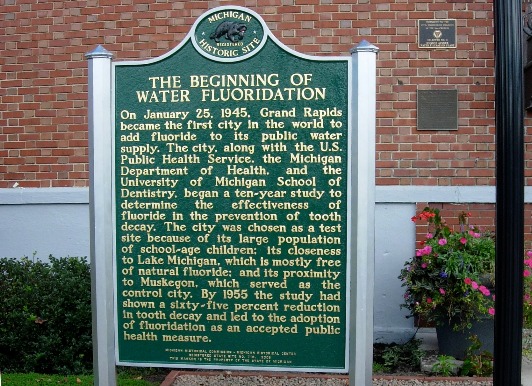The Fluoride Controversy Never Dies
Background
Fluoride research began in 1909 when Dr. Frederick McKay came to Colorado Springs, Colorado, to study the native residents, many of whom had brown-stained teeth (from mottled enamel), including 90% of the locally born children. Oddly, the researchers determined that these teeth were remarkably resistant to decay; after many years of investigation, the connection between the mottling and resistance to decay was found to be due to the naturally high fluoride levels in the drinking water.
 Public health organizations wondered whether adding fluoride to drinking water, at levels below that responsible for mottled enamel, would help fight tooth decay. In 1945, the City of Grand Rapids, Michigan, agreed to test this theory and became the first city in the world to fluoridate its public water supply. Researchers followed approximately 30,000 schoolchildren over 15 years. They reported that the cavity rate among Grand Rapids children born after fluoride was added to the drinking water dropped by more than 60 percent.
Public health organizations wondered whether adding fluoride to drinking water, at levels below that responsible for mottled enamel, would help fight tooth decay. In 1945, the City of Grand Rapids, Michigan, agreed to test this theory and became the first city in the world to fluoridate its public water supply. Researchers followed approximately 30,000 schoolchildren over 15 years. They reported that the cavity rate among Grand Rapids children born after fluoride was added to the drinking water dropped by more than 60 percent.
Over the years, water fluoridation has spread across the US; today, approximately 75% of the US population receives fluoridated water.
The Lawsuit
“to protect the public and susceptible populations from the neurotoxic risks of fluoride by banning the addition of fluoridation chemicals in water.”
In 2016, six organizations petitioned the EPA, under the Toxic Substances Control Act, claiming neurotoxicity to be a hazard of fluoride exposure and that the amount of fluoride regularly consumed by many people “exceeds the doses repeatedly linked to IQ loss and other neurotoxic effects.”
The EPA denied the petition in 2017, and subsequently, the organizations behind the petition sued EPA, resulting in a lawsuit in 2020. According to the executive director of the Fluoride Action Network, one of the organizations behind the petition and lawsuit,
“This case may be groundbreaking for environmental legal cases and at least as important, it is groundbreaking for the opposition to fluoridation. Opposition to fluoridation is now at least 70 years old but for most of that time has been wrongly dismissed as a fringe and unscientific position. The rapidly emerging science on developmental neurotoxicity, especially loss of IQ from early life exposure to fluoride, is a game changer. It has brought the world’s leading environmental health experts to not only engage in the science with the help of millions of dollars in National Institutes of Health funding, but also to conclude that the risk to children is too great to consider water fluoridation safe.”
The trial was stopped when the judge asked both sides to work out an agreement – they could not, and in January 2022, the judge said that he was not willing to continue the trial until the National Toxicology Program (NTP) published the final version of their report on the Neurotoxicity of Fluoride. The report was posted as a “draft” on its website in March 2023.
The NTP draft report concluded that:
- There is low confidence in the scientific association between fluoride exposure and adult cognition.
- There is moderate confidence in the scientific evidence for an association between higher fluoride exposure (> 1.5 mg/L) in drinking water and lower IQ in children.
- There is low confidence in the scientific evidence for an association between fluoride exposure and other cognitive or neurodevelopmental outcomes in children.
The confidence ratings are subjective conclusions based on an evaluation of the scientific data. They are not objective measurements and will differ depending on the group of scientists doing the review.
Of extreme importance, correlation (association) is not causation.
Because some studies showed that fluoride is associated with lower IQ levels does not mean that fluoride caused the result. Many additional factors need to be considered before causation can be determined. As discussed by ACSH, for fluoride to be considered the cause of lower IQ, it would need to satisfy Hill’s Nine Criteria of Causality – it violates several of the criteria, and causality has not been determined.
The NTP draft report was criticized for several reasons, including that it did not acknowledge the benefits of fluoride on oral health (The NTP responded that this was not the report’s focus). The American Dental Association criticized it for not providing a clear statement about the safety of low-level fluoride exposure, recommending a stand-alone disclaimer indicating that the report should not be construed as an indictment of low-level fluoride exposure.
The NTP draft report concluded that the only neurotoxic effect associated (with medium confidence) with fluoride exposure was the lowering of IQ.
Fluoride and IQ
Let us consider the only “neurotoxicity” of fluoride to have NTP’s medium confidence, a lowered IQ. IQ is a total score derived from a series of standardized tests designed to test intelligence. It is not a biological marker of neurotoxic effects. The average IQ score is always 100, and your score compares your IQ score with other people who took the same test.
Many chemicals have been linked with the lowering of IQ, including almost all pesticides, phthalates, perchlorate, arsenic, lead, mercury, cadmium, bisphenol A, and polybrominated diphenyl ether. But this association is because of the nature of the studies and IQ tests. These studies examine large populations for an association between average IQ scores and levels of chemicals measured in blood. Because IQ tests are considered to have a margin of error of approximately 5 points on either side, the studies showing statistically positive associations may not be truly “positive” but within the margin of error.
IQ tests are very poor measures of neurotoxicity. Better markers of neurotoxicity include objective tests identifying altered nerve conduction, sensory and motor skills, and brain architecture and metabolism. Hearing loss and tests on gross and fine motor skills are often used in studies investigating the neurotoxic effects of lead.
In the case of fluoride, EPA has boxed itself in by using association instead of causation as the basis for regulating many chemicals – including its recently proposed drinking water regulation for PFOA and PFOS. As with fluoridation, PFOA and PFOS have shown an association but not causation with three health outcomes [2] attributed to exposure to these chemicals.
The outcome of the court case could have implications far beyond water fluoridation. Suppose EPA stays wedded to correlation, especially in using social science constructs, such as IQ. In that case, they risk the courts failing to give them the same broad latitude in interpreting scientific studies that have existed in the past.
[1] That is more than twice the 0.7 mg/L recommended by the US Dept of Health and Human Services for treating public water supplies.
[2] Reductions in birth weight, increase in cholesterol, and renal (kidney) cancer.
This article has been archived for your research. The original version from American Council on Science and Health can be found here.


